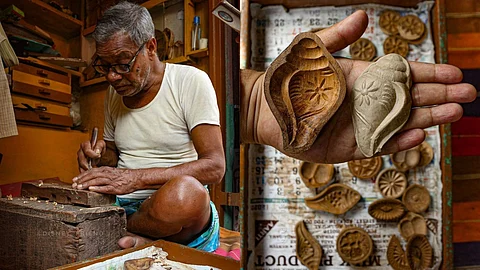
- HOMEGROWN WORLD
- #HGCREATORS
- #HGEXPLORE
- #HGVOICES
- #HGSHOP
- CAREERS
- ABOUT US
- CONTACT US

If you visit a Bengali household during the festive season, or any special occasion for that matter, chances are you will be treated to a platterful of traditional Bengali sandesh in many intricate designs like fish with individual crescent-shaped scales, ribbed, fan-shaped scallops, mango, and lotus flowers. Back in the day, when festive sweets were often made at home, the women would huddle together in the kitchen as the festivities approached and make sandesh with almost industrial assembly-line-like efficiency. Each woman would have her own station. The oldest and most experienced ones would make the dough from chhena (a kind of curdled cottage cheese), sugar, jaggery, and condensed milk, and the younger ones would press the dough — known as 'paak' — into different shapes using intricately carved stone, wood, or terracotta moulds.
Originally, these moulds were made at home from worn-out stone plates or leftover pieces of wood by the women themselves. They would chisel the stone or wood with a sharp knife and carve the designs onto the surface. But as sweet shops became more common and store-bought sweets became more popular in the 19th century, an entire cottage industry of making sandesh moulds emerged in Bengal. Woodworkers began making sandesh moulds from leftover pieces of long-lasting teak, mahogany, and sheesham wood. In Kolkata, many shops making and selling these moulds — called 'chhaanch' in Bengali — still populate Rabindra Sarani, one of the oldest thoroughfares in Kolkata.
The best chhaanch or moulds, with intricate patterns and motifs, are masterful works of miniature art. Most of these moulds come in the standard sandesh size of 2 inches across and feature fine details and traditional motifs like fish, conch shells, kodi or small, smooth, egg-shaped seashells historically used as currency in Bengal. To make a sandesh mould, a piece of wood is cut into small 2-inch blocks, and then the desired shape of a sandesh is cut out and a design is carved in using hand tools like hammers and chisels of different sizes and weights. The design, in relief, is carved in reverse, similar to a stamp or a coin. To make the moulds non-sticky, they are soaked in edible oil and air-dried, giving them a smooth, dark appearance.
The shift from homemade stone and terracotta moulds to commercially made wooden moulds proved to be a trigger for the industry. But now, a similar shift is happening away from wooden moulds. Sweet-sellers and confectioners are increasingly opting for metal, silicon, and plastic moulds for lower cost, longevity, and ease of use. With dwindling sales and increasing cost of raw materials, the once-thriving craft and business of making sandesh moulds is slowly fading away.
If you enjoyed reading this, here's more from Homegrown:
Raw Mango’s Latest Collection Is A Nomad-Inspired Tribute To India’s Craft Traditions
Rogan Art: How One Family Is Keeping A 400-Year-Old Gujarati Heritage Craft Alive
Annahmol’s 'Kada' In Kochi Is A Creative Playground Of Craft, Design, & Upcycling
